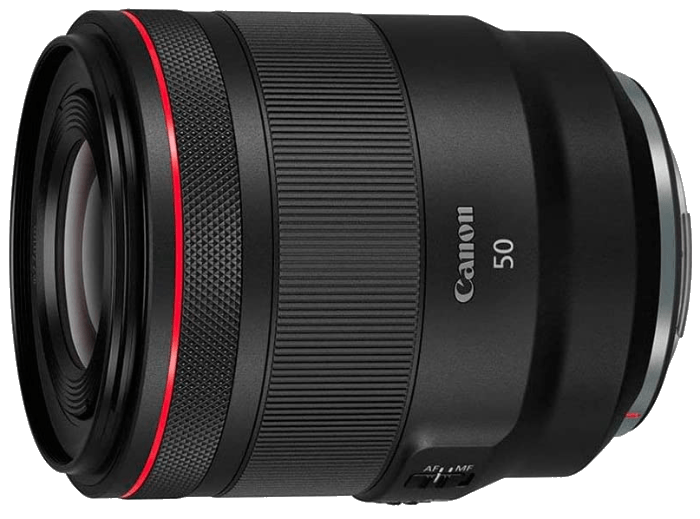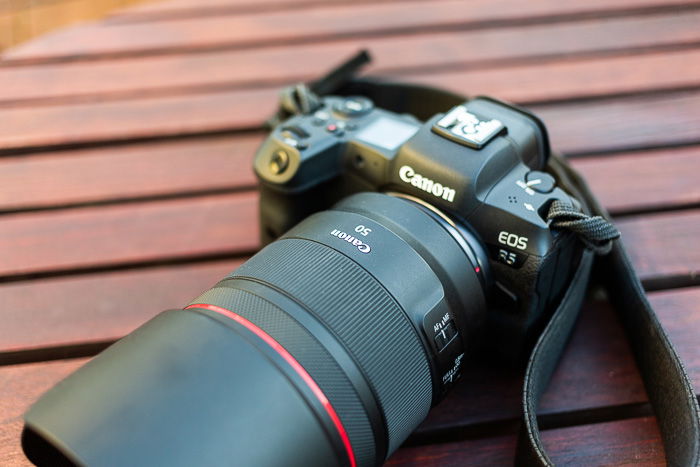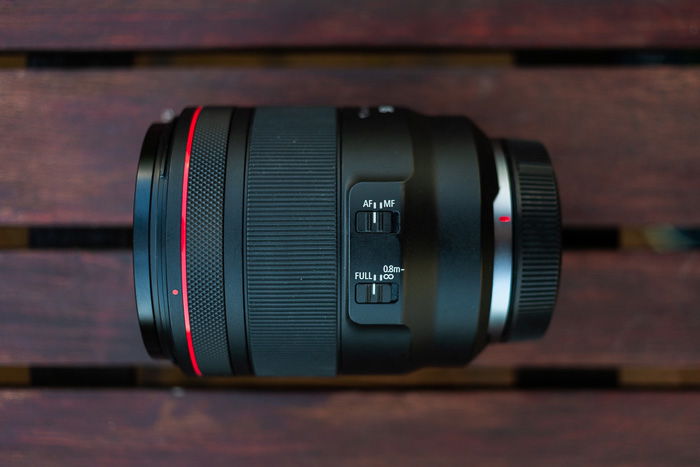The Canon RF 50mm f1.2 L USM is a high-end lens that offers excellent performance and stunning images. It’s perfect for portrait photography, as well as other types of photography where you need a fast aperture. Here are some of the key features of this lens.


| Brand |
Brand
Canon
|
| Lens Mount |
Lens Mount
Canon RF
|
| Maximum Aperture |
Maximum Aperture
f/ 1.2
|
| Focal Length Range |
Focal Length Range
50 mm
|
| Image Stabilization |
Image Stabilization
|
So, when reviewing the EOS R5 late last year, I decided to go ahead and test this 50mm prime as well. It proved to be a wise decision. This lens gets full use out of the technological pioneer camera body. The experiences depicted in today’s review thus mostly reflect use on the R5 – but image quality is similar on lower-resolution R bodies.
The Canon RF 50mm f/1.2L USM promises the highest level of image quality possible and its price reflects that – it’s higher than any Canon 50mm’s since the EF 50mm f/1.0L. It’s the indirect successor to the EF 50mm f/1.2L, with which I will make comparisons throughout this review. It represents a significant quality upgrade from pretty much any lens you happen to have previously used.
It’s a massive and heavy construction, in line with the other L lenses for the RF mount – it looks somewhat facetious on the relatively small R cameras.
In the box, you’ll find the lens, the beefy lens hood, the classic L-lens leather pouch, and the lens caps.
I received this lens for a testing period of three weeks from Canon UK, along with the EOS R5.
(Editor’s note: This article wasn’t sponsored by Canon.)
A lens like this inevitably has a limited audience due to the high investment it requires. Hence, I recommend this lens to photographers who are either professionals – able to justify the cost on purely business grounds – or passionate and experienced amateurs.
The RF 50mm f/1.2L excels in a range of genres, including, but not limited to portraiture, events and weddings, documentary work, conceptual photography, astrophotography, and fine art photography.
I used it a lot in a street photography context and achieved exceptional results (particularly at night).
Users of this lens need an EOS R-series camera body. I especially recommend the two recently released bodies, the R5 or the R6, because of their autofocus performance and incredible stabilization that transform any lens, but especially this one.
I don’t recommend this lens if you are on a limited budget. While I think it is worth the price, there are seriously great alternatives at a fraction of the price (see Alternatives section). You need to be both an experienced photographer and a nifty-fifty fan to appreciate the Canon RF 50mm f/1.2L USM.

The Canon RF 50mm f/1.2L USM is made for Canon’s RF mount and attaches to mirrorless R-series cameras. At the time of writing, there are five: the EOS R, EOS RP, EOS Ra, EOS R5, and EOS R6. This lens will not work on EOS DSLRs, such as the 5D and 1D series, nor on any other mirrorless system.
While this significantly limits its use, operation on either of these cameras will be smooth and rewarding.
The RF system of mirrorless-optimised lenses has been continuously growing in the past two years, and many more new lenses are expected this year. Currently, the only similar lens in the lineup is the RF 85mm f/1.2L.
The RF mount is an advanced, modern construction. Similar in size and design to the older EF mount, it has a much shorter flange distance, which allows for the particular rear-heavy optical design of this lens. It also increases communication bandwidth between the lens and the camera, enabling more detailed metadata, and new features such as the control ring.
A source of serious annoyance, especially in professional use, is the rearrangement of bayonet pins. On the EF mount, these are placed equally apart, so you can twist on the lens caps in three different positions without looking. With the RF mount, you have to align the lens and the cap carefully before attaching it, and it’s nearly impossible to do it unconsciously or in the dark.
The expectations of a flagship 50mm’s image quality today are very high. The bar has been continuously rising for the last decade. Even relatively budget-friendly options (e.g. the Sigma 50mm f/1.4 Art and the Nikon Z 50mm f/1.8) offer incredible performance. Of course, the price difference is partially explained by the half-stop advantage compared to f/1.4, but is the image quality also significantly better?
The answer, for the most part, is yes. The RF 50mm f/1.2L USM is not only incredibly sharp across the frame even at f/1.2, but its other optical characteristics are outstanding as well.
At f/1.2, this lens offers what would have been peak sharpness for 50mm lenses closed down just a few years ago. It reaches ultimate sharpness at around f/2, at which point the low-pass filter of the camera blocks you from seeing any more improvement.
Compared to the EF version, it’s slightly sharper in the center of the frame at all apertures, and a world away in sharpness towards the edges.
Its microcontrast is excellent, as has been a signature trait of L-lenses for a long time.
Chromatic aberration is very well controlled, pretty much non-existent. The lens is nearly distortion-free.
Vignetting is much less of an issue than on previous f/1.2 lenses, due to the large image projection beyond the area covered by the sensor.
Its bokeh (out-of-focus backgrounds) is clean and huge, as you’d expect at f/1.2. It lacks the swirly, circular pattern of the EF version lens, giving a more uniform, cleaner look.
Flare and ghosting are very well controlled. Still, I recommend keeping the lens hood on for protection.
Overall, this 50mm lens does indeed represent a new standard of image quality – certainly for Canon, but likely for the entire market.
The Canon RF 50mm f/1.2L USM is not stabilised, and will not give you any stabilization on EOS R, RP, and Ra cameras.
However, it is fully compatible with the sensor stabilization modules of the EOS R5 and R6 due to its massive projected image circle. This is also one of the reasons the lens is so big.
I was able to get 6.5 of stabilization in real-life use, not far off the claimed 7. For the lack of a better word, this is incredible, and also entirely unprecedented. At f/1.2, this allows you to shoot in pitch black handheld in good quality.
An area where all the EF f/1.2 lenses have lagged behind f/1.4 and f/1.8 counterparts is autofocus. While the RF 50mm f/1.2L USM is still slower compared to the brand-new RF L-series zooms, the difference is much less noticeable and its autofocusing speed doesn’t present any drawbacks in practical use. Keep in mind that the focusing elements in this lens are very heavy, so it needs a powerful motor to keep them moving. Its speed is comparable to the fastest EF L-series prime lenses.
The focusing front block moves in and out of the barrel but doesn’t reach the filter thread. You can mount filters that won’t move, and also seal off the lens.
The motor in this lens is a new version of a ring-type ultrasonic (USM) unit. These are optimised for use in continuous focusing on mirrorless cameras, particularly video and stills tracking.
There is probably no need to say that the system is nearly always accurate, in part thanks to the closed-loop nature of autofocusing with mirrorless cameras. It works smoothly with the eye and face detection and tracking systems of R-series camera bodies.<img class=”aligncenter wp-image-505018 size-full” src=”https://cdn.expertphotography.com/wp-content/uploads/2021/01/1D7A1054.jpg” alt=”A street photography image shot with the Canon RF 50mm f/1.2L USM mirrorless lens” width=”560″ height=”700″ />
The manual focus ring is not mechanically coupled to the optical elements. This means there is no full-time manual override. Instead, you need to half-press the shutter or use the back focusing button to activate it, depending on your settings.
Still, the manual focusing ring is smooth and precise. You can choose whether it responds linearly (equal turn = equal change), or not (the faster you turn it, the more it adjusts) from the camera menu. The former will be greatly appreciated by video shooters.
There is no focusing distance indicator or depth of field scale on the lens. This information is digitally displayed in the viewfinder and on the LCD if you choose so.
By default, the lens switches to idle (presumably infinity focus) when you switch off the camera. You can turn this off in the menu if you want to keep your focus.
This lens can focus as closely as 0.4m, which translates to a magnification of 0.19. This is a standard performance for 50mm-equivalent lenses.
L-series lenses are known to have excellent build quality. Slightly surprising is that the Canon RF 50mm f/1.2L USM (as all RF lenses) is covered in plastic. I’m sure that on the inside the construction is more solid. I’m also fairly certain that it’s no match to the ultra-durable feeling 24mm and 35mm primes of the EF era. On the other hand, the use of plastic definitely helps to keep the weight down.
Even so, this is among the heaviest 50mm primes on the market, at 950g. It’s also huge, measuring 90mm in diameter and 108mm in length, and the lens hood adds a further 64mm to that. This is not a lens that you can easily blend in with.
It has a 77mm filter thread and a plastic thread mount. As mentioned, the focusing elements move in and out, but you still attach a filter without it moving, because the thread sits above the moving parts. This is also advised in order to keep the lens better weather-sealed. Without it, while the lens is fully sealed, that gap presents a slightly worrying look from a protection standpoint.
On the side of the lens, there is an auto/manual focus switch and a focus limiter. I haven’t found a noticeable difference in speed between the limited and full settings on the EOS R5 – it might be useful on older bodies.
The manual focusing ring is smooth as precise. There is another ring, a control ring towards the front. This has a click mechanism and can be used to adjust a range of settings, such as aperture or ISO. Canon service centres can de-click it (for a fee) for smoother exposure adjustments.
Overall, while not the best I’ve seen, the Canon RF 50mm f/1.2L USM is built excellently.
There are a couple of lenses you might want to consider over the Canon RF 50mm f/1.2L USM.
If you need the f/1.2 aperture and weather-sealing, but not the incredible sharpness, the older, EF 50mm f/1.2L with an adaptor is a viable option. Some photographers prefer the look of this lens, stating it gives a more organic feel to images as opposed to the nearly clinical sharpness of the new lens. Its autofocus is not so quick, and its front element moves in and out of the barrel along with the filters attached. It is available at a significantly lower price.
The Sigma 50mm f/1.4 Art is also an EF-mount lens. It has been on the market for 7 years now, but its sharpness ensures that it will remain popular for many years to come. At a third of the price, most photographers are likely to choose this lens over any Canon-made option. The difference in autofocus speed in favour of the RF 50mm f/1.2L USM and the lack of weather-sealing is definitely worth keeping in mind. Nonetheless, the 50mm Art is an excellent lens.
The Canon RF 50mm f/1.2L USM is the most incredible 50mm lens produced by Canon to date. Yes, it’s expensive. But if you can justify the cost in one way or another, the results you get are as rewarding as it gets.
I recommend that you use this lens on one of Canon’s new EOS R-series bodies – but it will give you excellent quality on any camera.
| Measurement |
Measurement
Score
|
| Build and Handling |
Build and Handling
|
| Focusing |
Focusing
|
| Image Quality |
Image Quality
|
| Miscellaneous |
Miscellaneous
|
| Value for Money |
Value for Money
|
| Total Score |
Total Score
|

